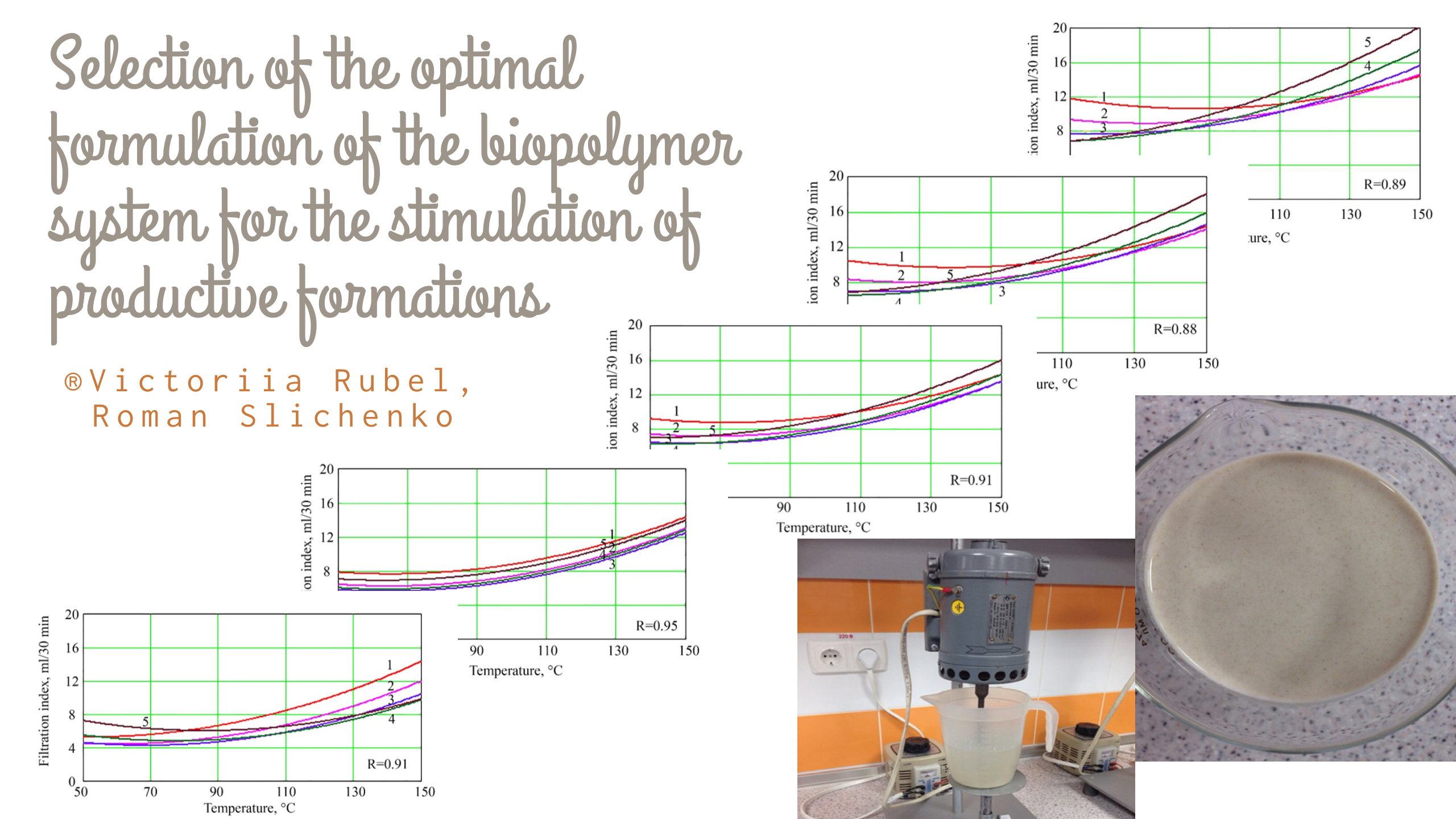Selection of the optimal formulation of the biopolymer system for the stimulation of productive formations
DOI:
https://doi.org/10.15587/2706-5448.2024.314230Keywords:
biopolymer system, drilling mud, colmatant, filtration, well, rheological parameters, regression modelAbstract
The object of study in this paper is the biopolymer system «X» – a complex composition that includes a biopolymer, salts and a thermal stabiliser intended for use in drilling fluids at high temperatures. The components of the formulation include complex reagent «X» for regulating structural, mechanical, rheological and filtration properties, as well as inhibitors (sodium and potassium chloride) and filler. Components of the biopolymer system (sodium chloride, organo-mineral colmatant thermal stabiliser) increase its thermal stability. One of the most problematic areas is the mechanism of sodium chloride's thermal stabilising effect. It is associated with an increase in the overall mineralisation of the drilling mud, which leads to a certain conformation of biopolymer molecules, accelerates gelation processes and counteracts the temperature dilution of the system.
The results obtained can be explained as follows:
– an increase in the concentration of sodium chloride leads to an increase in the ionic strength of the solution, which contributes to a change in the conformation of biopolymer molecules, enhancing intermolecular interactions and, as a result, increasing the viscosity and stability of the system;
– the organo-mineral colmatant heat stabiliser promotes the formation of a filtration crust on the well walls, which prevents fluid loss and reduces rock permeability;
– all components of the system interact with each other, affecting the properties of the solution. The optimum ratio of components allows achieving the required rheological characteristics and ensuring the stability of the system at high temperatures.
As a result of processing the information on technologies for tapping productive horizons, the disadvantages and advantages of each of them were noted. The existing drilling fluid systems used to tap productive horizons at high temperatures were considered. However, more attention was paid to the selection of a new optimal formulation of the biopolymer system, in accordance with the specified rheological and structural and mechanical properties for further implementation in practice. This ensures the possibility of obtaining predictive parameters of the drilling mud.
The proposed system has a number of advantages over similar ones, namely:
– the system retains its properties at high temperatures;
– the system provides the required values of viscosity, filtration and static shear stress;
– due to the use of an optimal formulation, high efficiency is achieved at a relatively low cost.
References
- Vasylchenko, A. O., Kusturova, O. V., Mysliuk, M. A. (2008). Do vyboru systemy burovoho rozchynu. Naftova i hazova promyslovist, 6, 10–12.
- Mysliuk, M. A., Salyzhyn, Yu. M. (2007). Systema vyboru optymalnykh retseptur obrobky burovykh rozchyniv. Naftova i hazova promyslovist, 5, 25–28.
- Petruniak, M., Rubel, V., Chevhanova, V., Kulakova, S. (2021). Application of grout slurries with the defecate addition for effective well cementing. Mining of Mineral Deposits, 15 (1), 59–65. https://doi.org/10.33271/mining15.01.059
- Page, J. C., Miskimins, J. L. (2009). A Comparison of Hydraulic and Propellant Fracture Propagation in a Shale Gas Reservoir. Journal of Canadian Petroleum Technology, 48 (5), 26–30. https://doi.org/10.2118/09-05-26
- Rubel, V., Rubel, V., Surzhko, T., Goshovskyi, S. (2024). Determining the effect of vibrating wave swabbing on the functional processes in carbonate low-permeability reservoirs. Eastern-European Journal of Enterprise Technologies, 2 (1 (128)), 14–20. https://doi.org/10.15587/1729-4061.2024.299970
- Bodnar, R. T., Kysil, I. S. (2010). Kontrol poverkhnevoho natiahu vidborom z rukhomykh rozchyniv poverkhnvo-aktyvnykh rechovyn. Pidvyshchennia efektyvnosti burinnia sverdlovyn ta intensyfikatsii naftohazovydobutku na rodovyshchakh Ukrainy. Ivano-Frankivsk, 44–48.
- Polutrenko, М. S., Bogoslavets, V. V., Voloshyn, Yu. D. (2021). Study of surface and rheological properties of clayless biopolymer drilling mud treated with M-1 surfactants. Oil and Gas Power Engineering, 1 (35), 91–97. https://doi.org/10.31471/1993-9868-2021-1(35)-91-97
- Boyer, C., Figueiredo, L., Pace, R., Lesoeur, J., Rouillon, T., Visage, C. L. et al. (2018). Laponite nanoparticle-associated silated hydroxypropylmethyl cellulose as an injectable reinforced interpenetrating network hydrogel for cartilage tissue engineering. Acta Biomaterialia, 65, 112–122. https://doi.org/10.1016/j.actbio.2017.11.027
- Gu, M., Fan, S., Zhou, G., Ma, K., Yao, X., Zhang, Y. (2022). Effects of dynamic mechanical stimulations on the regeneration of in vitro and in vivo cartilage tissue based on silk fibroin scaffold. Composites Part B: Engineering, 235, 109764. https://doi.org/10.1016/j.compositesb.2022.109764
- Salati, M. A., Khazai, J., Tahmuri, A. M., Samadi, A., Taghizadeh, A., Taghizadeh, M. et al. (2020). Agarose-Based Biomaterials: Opportunities and Challenges in Cartilage Tissue Engineering. Polymers, 12 (5), 1150. https://doi.org/10.3390/polym12051150

Downloads
Published
How to Cite
Issue
Section
License
Copyright (c) 2024 Viktoria Rubel, Roman Slichenko

This work is licensed under a Creative Commons Attribution 4.0 International License.
The consolidation and conditions for the transfer of copyright (identification of authorship) is carried out in the License Agreement. In particular, the authors reserve the right to the authorship of their manuscript and transfer the first publication of this work to the journal under the terms of the Creative Commons CC BY license. At the same time, they have the right to conclude on their own additional agreements concerning the non-exclusive distribution of the work in the form in which it was published by this journal, but provided that the link to the first publication of the article in this journal is preserved.







